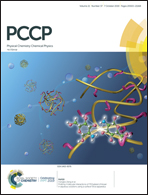Modulation of amyloid β peptide aggregation by hydrophilic polymers†
Abstract
A substantial number of diseases leading to loss of neurologic functions such as Morbus Alzheimer, Morbus Parkinson, or Chorea Huntington are related to the fibrillation of particular amyloidogenic peptides. In vitro amyloid fibrillation strongly depends on admixture with other proteins and peptides, lipids, nanoparticles, surfactants and polymers. We investigated amyloid-beta 1–40 peptide (Aβ1–40) fibrillation in mixture with thermoresponsive poly(oligo(ethylene glycol)macrylates), in which the polymer's hydrophobicity is tuned by variation of the number of ethylene glycol-units in the side chain (m = 1–9), the end groups (B = butoxy; C = carboxy; D = dodecyl; P = pyridyldisulfide) and the degree of polymerization (n) of the polymers. The polymers were prepared via RAFT-polymerization, obtaining a broad range of molecular masses (Mn = 700 to 14 600 g mol−1 kDa−1, polydispersity indices PDI = 1.10 to 1.25) and tunable cloud point temperatures (Tcp), ranging from 42.4 °C to 80 °C, respectively. Proper combination of hydrophobic end groups with hydrophilic side chains of the polymer allowed to alter the hydrophilicity/hydrophobicity of these polymers, which is shown to enhance Aβ1–40 aggregation significantly in case of the endgroup D (with n = 16, 23, 56). We observed that the less hydrophilic polymers (m = 1–2) were able to both decrease and elongate the lag (tlag) and characteristic times (tchar) of Aβ1–40 fibril formation in dependence of their end groups, molecular mass and hydrophilicity. On the other hand, highly hydrophilic polymers (m = 3, 5, 9) either decreased, or only marginally influenced the lag and characteristic times of Aβ1–40 fibrillation, in all cases forming β-sheet rich fibrils as observed by TEM and CD-spectroscopy. Our results support that balanced hydrophobic and hydrophilic interactions of a polymer with Aβ1–40 is important for inhibiting amyloid-formation pathways.



 Please wait while we load your content...
Please wait while we load your content...